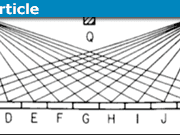Learn Complex and Irrational Exponents for the Layman
This Insight is part of our “Young Authors” series, where talented young students showcase their knowledge.
This is how both you and I learned it back in elementary school.
$$5^3 = 5*5*5$$
Using this you can raise anything to any power- as long as that power is a whole number. What about fractions and negative numbers? Well, that’s covered in algebra 1; ##5^{-3} = 1/5^3## and ##5^{3 / 2} = \sqrt{5^3}##. Both of these can be calculated using repeated multiplication or the inverse of repeated multiplication, roots. Now we get to imaginary and irrational numbers. The definition of exponents being repeated multiplication breaks down here. What does it mean to multiply something by itself an irrational amount of times? Better yet, what does it mean to multiply something by itself an imaginary amount of times? This is where exponents need to be redefined.
First, let’s get a few definitions and basic properties down:
$$0!=1$$
$$x^0=1$$
$$x^1=x$$
$$e=1/0!+1/1!+1/2!+1/3!…≈2.718$$
$$i^2=-1$$
$$i^3=-i$$
$$i^4=1$$
$$i^5=i$$
$$i^6=-1$$
If you understand those and the laws of exponents, you should be good to go for this explanation.
Now, let’s define ##e^x##as the equation
##e^x = x^0 /0!+x/1!+ x^2 /2!…##
and then ##x^y## as the equation
##x^y = e^{y*ln(x)}##, where x≠0, and the natural logarithm (ln) is defined as ##e^{ln(x)}=x##. If you substitute the previous equation into ##x^y##, you will get ##(e^{ln(x)})^y## or ##e^{y*ln(x)}##. This should clear up the concept of irrational exponents a little bit, because x can clearly be irrational and still work with these equations.
And, both of these are easy enough to prove:
##e=e^1=1^0/0!+1^1/1!+1^2/2!…=1/0!+1/1!+1/2!…##
##1=e^0=0^0/0!+0^1/1!+0^2/2…=1+0/1+0/2…##
and
##e^3=e^{3*ln(e)}##
##1^2=e^{2*ln(1)} = e^{2*0}=e^0=1##.
We now can take any exponent and, using Euler’s number, natural logarithms, and factorials, express it in terms where we can use the idea of repeated multiplication. You could say that this is a stretch of “the rules” if you say that the properties ##e^x=x^0/0!+x/1!+x^2/2!…## and ##x^y=e^{y*ln(x)}## are a consequence of repeated multiplication, so instead, think of it the other way around. Repeated multiplication is a consequence of ##e^x=x^0/0!+x/1!+x^2/2!…## and ##x^y=e^{y*ln(x)}## because of the property ##x^{y+z}=x^y*x^z##. Then, we can rewrite ##5^3## as ##5^1*5^1*5^1## or ##5*5*5##. You can easily prove that all exponent rules are consistent with this new definition of exponents by solving any problem on a calculator with both repeated multiplication/fractional and negative exponents rules and ##x^y=e^{y*ln(x)}##.
This definition of exponents fits everything we know about exponents, and it can do more.
The idea of repeated multiplication and the laws of exponents can handle e irrational exponents, which you may get with natural logarithms. Because you can express any irrational number as an infinite sum, you could say ##e^π=e^3e^{1/10}e^{4/100}e^{1/1000}…##. This won’t work, however, when you get to imaginary exponents.
When you have imaginary exponents, you need to think of this differently. Using e, there is a very good way of thinking about this. Imagine a unit circle on a coordinate plane, where the x-axis is the real number line and the y axis is the imaginary number line. Now think of point 1. This is where you start when doing anything with ##e^{xi}##. To use these imaginary exponents, you simply move the point for 1 x radians around the unit circle. Unless x is a multiple of π/2, you will get a combination of imaginary and real numbers. If x is equal to π, 1 gets translated half of the way around the circle to -1. This is Euler’s formula. You can also see how ##e^{xi}=cos(x)+isin(x)## makes sense because any point on a unit circle can be called (cos(x), sin(x)), and the y component on a regular Cartesian coordinate is the imaginary component on our number grid.
You can also have real and imaginary exponents at the same time. If you think about the unit circle, to raise e it to a real exponent x, means you stretch or compress it by x, and you do that x times. After that, you stretch it by e and you then apply the imaginary exponents.
In fact, you can express all four of the basic operations with both real and imaginary numbers as actions on a number grid. Adding and subtracting real numbers moves the grid left and right (or it moves points on the grid right and left), respectively. Adding and subtracting imaginary numbers do the same thing but up and down. Multiplying and dividing real numbers compresses and stretches the grid (or stretches and compresses shapes), respectively. Finally, multiplying and dividing imaginary numbers rotates the grid clockwise and counterclockwise (or it makes points spin around zero counterclockwise and clockwise), respectively.
As you start dealing with complex numbers, redefining these operations can become very useful.
Thank you to Professor Tom Imbo for helping me learn this material.
This Insight is part of our “Young Authors” series, where talented young students showcase their knowledge.
This article was authored by several Physics Forums members with PhDs in physics or mathematics.




[QUOTE=”Samy_A, post: 5363318, member: 574914″]I took me some time to more or less get what you were saying here:
“[I]You can also have real and imaginary exponents at the same time. If you think about the unit circle, to raise e it to a real exponent x, means you stretch or compress it by x, and you do that x times. After that, you stretch it by e and you then apply the imaginary exponents.[/I]”[/QUOTE]
If I knew how to make and add in an animation of this, it would have probably made that section of the article more understandable.
Very good.
What’s a compliment worth without a nitpick or two:
I would specify in “[I]Unless x is a multiple of π/2, you will get a combination of imaginary and real numbers[/I].” that it must be an [B]integer [/B]multiple of π/2.
I took me some time to more or less get what you were saying here:
“[I]You can also have real and imaginary exponents at the same time. If you think about the unit circle, to raise e it to a real exponent x, means you stretch or compress it by x, and you do that x times. After that, you stretch it by e and you then apply the imaginary exponents.[/I]”
[QUOTE=”Borg, post: 5363169, member: 185214″]Congratulations on a fine Insights post. Very nice. :smile:[/QUOTE]
Thank you very much :smile:.
Congratulations on a fine Insights post. Very nice. :smile:
Way up ahead! Brilliant, Isaac!